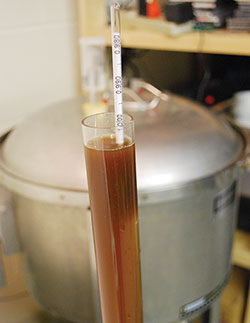Calculating Final Gravity
TroubleShooting
Clinton Fischer - Adelaide, South Australia asks,
Could you give some tips or advice on how to best calculate the final gravity of a beer? I often nail the original gravity (OG) down by knowing my system efficiency, but occasionally I am let down by my final gravity differing from brewing software predictions.
Calculating the final gravity of a beer is simply a rough approximation because there are too many things affecting final gravity to produce a very accurate estimate. A common estimate is to multiply your gravity points by 0.25 (1.056 has 56 gravity points so the predicted final gravity (FG) would be 14 points or 1.014). Wort fermentability, wort original gravity (i.e., high gravity worts), yeast strain, wort nutrients, wort aeration, and fermentation temperature can all influence a beer’s final gravity. For many beers, the final gravity is something that is discovered during fermentation.
A batch began as 1.056 wort and ended up as 1.018 beer, and after three gravity checks at 1.018 the beer was bottled. Sounds pretty familiar, right? But 1.018 is still pretty high, and when 18 (FG points) is compared to 56 (OG points) we see that the apparent degree of fermentation (ADF) is 68%. ADF can be calculated by the following equation:
ADF% = (OG-FG)/(OG)x100.
ADF is a good number to calculate because beers of similar OG, fermented with the same yeast strain, under “normal” conditions tend to have similar ADF values. This value is often published by yeast suppliers as a property of yeast, and the same strain is not always described the same by different suppliers. Wyeast shows the attenuation of their strain 1056 (American Ale) between 73–77%, and White Labs shows the attenuation of their strain WLP001 (California Ale) between 73–80%; similar, but not the same (most brewers believe these are the same yeast strain).
The differences in these ranges does not mean that one of these suppliers is incorrect, but has more to do with what ADF really is. ADF is a property of wort, not yeast, but since nothing is known about the wort that various brewers may produce sometime in the future, we often look to yeast properties when trying to predict what may happen. There is nothing wrong with this in most cases because the actual ADF/FG is simply a property of the beer, and most brewers don’t really care if their beer finishes at 1.014 versus 1.018. Brewers do care if their beer finished at 1.018, but somehow woke up when bottled and started fermenting again because this usually results in over-carbonated bottles, and may end up producing bottle bombs.
The best way to predict the FG of the next batch you brew is by using a time machine instead of a calculator. A time machine allows you to know the FG of your current batch before the batch finishes. Brilliant! The great news is that this time machine has a name, and is called the Forced Fermentation Test (FFT). The equipment you need to perform this test by the books includes a 500 mL Erlenmeyer flask, a magnetic stir bar, a stir plate, and a large wad of cotton. What you put into the flask is wort and yeast (about 5–10 times more than you typically use for fermentation). The FFT is easy to perform; simply put about 200 mL of wort, 1 gram of dried yeast or equivalent liquid yeast, and the stir bar in your flask, stuff the wad of cotton in the opening of the flask, put the assembly on the stir plate for 36-48 hours, and measure the FG at the end of the test.
The results of the FFT are much more reliable than calculating FG based on numerous assumptions and is a great indicator. One of the challenges of this test is having sufficient yeast for the test. If you use dried yeast, things are very easy. For those brewers using liquid slurries, you can either grow up some extra yeast for the test or use a dried yeast with similar properties as the strain you plan on using.

